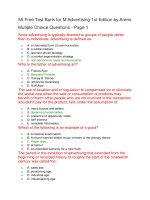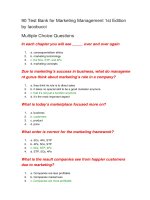TEST BANK AYROLL ACCOUNTING 2015 1ST EDITION LANDIN chap002 revision
Bạn đang xem bản rút gọn của tài liệu. Xem và tải ngay bản đầy đủ của tài liệu tại đây (187.53 KB, 72 trang )
Chapter 02
Payroll System Procedures
True / False Questions
1The two main focuses of payroll procedures are company needs and governmental rules.
.
True
False
2Employers may choose to omit the employees’ Social Security numbers in their employee files.
.
True
False
3Semimonthly payroll involves a pay cycle in which pay disbursements occur every two weeks.
.
True
False
4Newly hired employees must be reported to governmental officials within 20 days of starting working with an emp
.
True
False
5Foreign workers in the United States are subject to new hire reporting regulations.
.
True
False
6A worker who sells life insurance on a full-time basis is considered a statutory employee.
.
True
False
7U.S. workers in foreign subsidiaries are exempt from income taxes.
.
True
False
8Pay rate is the first payroll system decision a company must make.
.
True
False
9Holiday hours, sick time taken, and vacation days are not considered in the worked hours for overtime computatio
.
True
False
2-1
Copyright © 2015 McGraw-Hill Education. All rights reserved. No reproduction or distribution without the prior written consent of
McGraw-Hill Education.
1 Separation of duties is not considered a payroll best practice.
0.
True
False
Multiple Choice Questions
1 Which of the following is not an important decision that an employer must make regarding its payroll procedures?
1.
A.
How often to pay
employees?
B.
How to handle pay
advances?
C.
How many employees to
hire?
D.
Which employee benefits to
offer?
1 Which of the following items must exist in every employee's payroll file?
2.
A.
Spouse's social security
number
B. Employment
history
C.
Spouse's birth
date
D. Occupatio
n
2-2
Copyright © 2015 McGraw-Hill Education. All rights reserved. No reproduction or distribution without the prior written consent of
McGraw-Hill Education.
1 According to the Fair Labor Standards Act, why must pay period information be a part of an employee’s payroll file
3.
A.
As a means of tracking time worked for overtime compensation
purposes.
B.
To ensure that the employee receives all compensation
earned.
C.
As a means of ensuring pay equality among
employees.
D.
To document satisfaction of court-ordered
obligations.
1 Which of the following is not a purpose of new hire reporting laws?
4.
A.
To ensure payment of court-ordered obligations like garnishments and
child support.
B.
To keep track of workers throughout their
careers.
C.
To ensure that the employee may legally work in the
United States.
D.
To keep track of workers and professionals who are subject to licensing
regulations.
2-3
Copyright © 2015 McGraw-Hill Education. All rights reserved. No reproduction or distribution without the prior written consent of
McGraw-Hill Education.
1 Which pay frequency has 24 pay periods annually?
5.
A.
Weekl
y
B. Biweekl
y
C. Semimonthly
D. Semiweekly
1 Which pay frequency has 26 pay periods per year?
6.
A. Bimonth
ly
B. Biweekl
y
C. Semimonthly
D. Semiweekly
1 Which of the following is not a commonly used pay frequency?
7.
A. Dail
y
B. Weekl
y
C. Monthl
y
D. Quarter
ly
1 What form is the first step in employer documentation?
8.
A. W4
B. I9
C. SS4
D. W2
2-4
Copyright © 2015 McGraw-Hill Education. All rights reserved. No reproduction or distribution without the prior written consent of
McGraw-Hill Education.
1 Ibrahim is the payroll accountant for a firm. He notes that the firm has hired a new employee. What forms must h
9. new employee?
A. W-2 and I9
B. W-4 and I9
C. W-4 and I8
D. W-3 and I9
2 If a firm pays its employees biweekly, how often does it disburse employee compensation?
0.
A. Twice per
week
B. Every
week
C. Every two
weeks
D. Every three
weeks
2 Why is it important for an employer to classify as worker as either an employee or an independent contractor?
1.
A. For tax reporting
purposes
B. For child support obligations
purposes
C. For government tracking
purposes
D. For reimbursement
purposes
2 Which of the following is not a purpose of new hire reporting?
2.
A. Immigration agency
tracking
B. COBRA benefits
administration
C. Communications of ethics violations for clerical
workers
D. Child support obligations
tracking
2-5
Copyright © 2015 McGraw-Hill Education. All rights reserved. No reproduction or distribution without the prior written consent of
McGraw-Hill Education.
2 An employer must have an employee complete Form W-4:
3.
A.
Before each pay
disbursement.
B.
Each year, upon the employee’s anniversary with
the firm.
C.
Every January
1.
D.
At the time of
hire.
2
4. Josh, who is 21 years of age, is a new employee of XYZ Company. To establish his identity and employment auth
present:
A.
His current United States
passport.
B.
His library card and birth
certificate.
C.
His driver’s license and ATM
card.
D.
His college transcript and driver’s
license.
2-6
Copyright © 2015 McGraw-Hill Education. All rights reserved. No reproduction or distribution without the prior written consent of
McGraw-Hill Education.
2 Which items must be contained in every hiring packet issued by an employer?
5.
A. Forms W-4 and
I-9
B. Employment contract with start date and pay
agreement
C. Descriptions of benefits and enrollment
forms
D. No items are mandated for issuance in a hiring
packet
2
6. The _____________ mandated that new hires must be reported within ________ days to state authorities.
A.
Fair Labor Standards Act,
30.
B.
Immigration Reform Act,
20.
C.
Civil Rights Act,
25.
D.
Davis-Bacon Act,
28.
2 Multistate employers must not do which of the following for new hire reporting:
7.
A.
File a report with the state offices for the employee's state of
residence
B. File a report with the IRS since they have employees in
multiple states
C. Designate which state will receive their new hire
reporting
D.
File a new-hire report with both states that contains the firm's headquarters and the
state that is the employee's primary residence
2-7
Copyright © 2015 McGraw-Hill Education. All rights reserved. No reproduction or distribution without the prior written consent of
McGraw-Hill Education.
2 Which entity bears the responsibility for gaining approval for a foreign worker visa so a foreign employee may wo
8. United States?
A. The
employer
B. The
employee
C. The U.S. State
Department
D.
The employer's home
country
2 Abigail is a full-time worker whose primary occupation involves extensive overnight travel to visit wholesaler sites
9. single company. Which of the following classifications most accurately describes Abigail's employment status?
A. Independent
contractor
B. Exempt
employee
C. Nonexempt
employee
D. Statutory
employee
3 Allen is an employee of the foreign subsidiary of a United States based company who lives and work in the United
0. According to FATCA, how much of his wages may Allen exclude from United States' taxes, according to 2013 guide
A. Non
e
B. $46,50
0
C. $79,85
0
D. $97,60
0
2-8
Copyright © 2015 McGraw-Hill Education. All rights reserved. No reproduction or distribution without the prior written consent of
McGraw-Hill Education.
3 Which of the following factors is not a determinant in pay rate?
1.
A. Employee
skill
B. Company
location
C. Employee
age
D. Industry
benchmarks
3 Georgeanne works in a company for which her primary job function is the sale of company products to consumers
2. percentage of each sale. Her compensation contains a _____________ element.
A. Piecerate
B. Commissio
n
C. Pay-forperformance
D. Nonexem
pt
3
3. Stan works for a bakery for which part of his compensation is based on the decoration of wedding and other s
compensation has a ____________ element.
A.
Performance
incentive
B.
Commissio
n
C.
Piecerate
D.
Nonexem
pt
2-9
Copyright © 2015 McGraw-Hill Education. All rights reserved. No reproduction or distribution without the prior written consent of
McGraw-Hill Education.
3 Which of the following is not subject to overtime in the process of hourly computations?
4.
A. Time worked in excess of eight hours
per day
B. Holiday, sick time, and paid
time off
C. Time worked in excess of 40 hours per
week
D. Nonexempt employee weekend
work
3 Which of the following is pervasive in the accounting system?
5.
A. Internal
review
B. Audit
control
C. Internal
control
D. Audit
review
3 A payroll review process increases in complexity when:
6.
A.
The company is has few departments and few
employees.
B.
The company is geographically
dispersed.
C.
The company is centralized and uses one
location.
D.
The company has multiple departments and many
employees.
2-10
Copyright © 2015 McGraw-Hill Education. All rights reserved. No reproduction or distribution without the prior written consent of
McGraw-Hill Education.
3 Outsourcing the payroll process:
7.
A.
Relieves the company of the task completion and the review
process.
B.
Relieves the company of some of the task completion but not the
review process.
C.
Relieves the company of all liability for payroll completion and
accuracy.
D.
Relieves the company of the review process but not the task
completion.
3
8. A company should assign _________________ employee(s) the responsibility for signing payroll checks and disburse
A.
A limited
number of
B.
Only
one
C.
Its most
responsible
D.
None of
the
2-11
Copyright © 2015 McGraw-Hill Education. All rights reserved. No reproduction or distribution without the prior written consent of
McGraw-Hill Education.
3
9. Which of the following is not a consequence of incorrect calculation of employee time for payroll purposes?
A.
Federal penalties for not remitting all
taxes due
B.
Erosion of available cash because of overpayments to
employees
C.
Increased stakeholder approval due to employee
overpayments
D.
An increase in legal proceedings initiated by
employees
4
0. For payroll documentation purposes, when an employee needs time away from work:
A.
The supervisor should authorize it
verbally.
B.
The employee should email only department
colleagues.
C.
Upper management must approve the
request.
D.
The request should be documented and forwarded to the
payroll clerk.
2-12
Copyright © 2015 McGraw-Hill Education. All rights reserved. No reproduction or distribution without the prior written consent of
McGraw-Hill Education.
4
1. When a payroll clerk receives an approved request for an employee’s time away from work, he or she should:
A.
Immediately place it in the
employee’s file.
B.
Attach it to the employee’s time collection report for the
pay period.
C.
Destroy the document in accordance with
privacy laws.
D.
Contact the employee to verify the
request.
4
2. A company should restrict access to payroll files (paper and/or electronic) as a part of _________________.
A.
File security internal
controls
B.
Audit trail
requirements
C.
Compliance with company
policy
D.
FATCA
requirements
2-13
Copyright © 2015 McGraw-Hill Education. All rights reserved. No reproduction or distribution without the prior written consent of
McGraw-Hill Education.
4
3. Which aspect of internal controls for payroll relates to the Sarbanes Oxley Act?
A.
Protecting employee retirement
funds
B.
Limiting the number of employees authorized to
disburse payroll
C.
Cross-training employees and altering
duties
D.
Ensuring the complexity of the
audit trail
4
4. Employee file maintenance is the responsibility of the:
A.
Employe
e.
B.
Employe
r.
C.
Payroll
vendor.
D.
State
government.
2-14
Copyright © 2015 McGraw-Hill Education. All rights reserved. No reproduction or distribution without the prior written consent of
McGraw-Hill Education.
4
5. Computerized payroll records are considered a(n):
A.
Open
system.
B.
Open
access.
C.
Closed
system.
D.
Closed
access.
4
6. When developing the internal controls for a payroll system, a company should:
A.
Involve all company employees to promote
transparency.
B.
Develop a closed system and alternate employee
duties.
C.
Designate a single employee with the responsibility for pay
disbursements.
D.
Train accounting personnel on a single
payroll task.
2-15
Copyright © 2015 McGraw-Hill Education. All rights reserved. No reproduction or distribution without the prior written consent of
McGraw-Hill Education.
4
7. The retention period for payroll documents commences:
A.
At the time an employee is
hired.
B.
When an employee completes new hire
paperwork.
C.
Once the employee completes one year of
service.
D.
When an employee terminates
employment.
4
8. Which of the following does not legally have access to a firm’s payroll records?
A.
The
IRS
B.
State revenue department
employees
C.
All employees of the
firm
D.
The Department of Homeland
Security
2-16
Copyright © 2015 McGraw-Hill Education. All rights reserved. No reproduction or distribution without the prior written consent of
McGraw-Hill Education.
4
9. Which of the following is false about document destruction requirements?
A.
Federal legislation required documents to be retained for two years after the
employee’s termination.
B.
Personnel records must be maintained for three years after
termination.
C.
Union employees’ records must be retained for five years after
termination.
D.
State legislation requires records to be retained for a minimum of eight years after
termination.
5
0. Mako was an employee of the Jaeger Corporation. After she voluntarily terminated employment, auditors discover
fraudulent activity that they traced to her. Mako’s records must be retained:
A.
For 10
years.
B.
For 15
years.
C.
For 20
years.
D.
Indefinitel
y.
2-17
Copyright © 2015 McGraw-Hill Education. All rights reserved. No reproduction or distribution without the prior written consent of
McGraw-Hill Education.
5
1. Max Johnson was terminated from a company because of a reduction in workforce. Which statement best describe
package requirements?
A.
No severance package is
required.
B.
He must receive at least one months’ wages or
salary.
C.
He must receive a settlement equal to half his
annual salary.
D.
He must receive a fixed dollar amount because he was
laid-off.
5
2. Natalie is involuntarily terminated by a company in Alabama. According to state regulations, when must she recei
A.
On the next business
day
B.
No state guidelines
exist
C.
Within seven business
days
D.
At the next schedule
payday
2-18
Copyright © 2015 McGraw-Hill Education. All rights reserved. No reproduction or distribution without the prior written consent of
McGraw-Hill Education.
5
3. A firm needs to destroy paper payroll records after the end of the retention period. Which of the following is not a
A.
Shreddin
g
B.
Discardin
g
C.
Pulpin
g
D.
Burnin
g
5
4. Geoff is the payroll clerk for a firm that maintains its payroll through computerized records on a centralized serve
responsibilities is employee file maintenance, including the destruction of records after the retention time has ela
of purging employee records is to delete the file from the database. What other record destruction procedures sho
A.
None. His method is
acceptable.
B. He should check all other employees’ computers to ensure that the record
is deleted.
C.
He should purge the record from the server and all
backups.
D. He should send an interoffice request to have someone in the information technology
department remove the record from the server.
2-19
Copyright © 2015 McGraw-Hill Education. All rights reserved. No reproduction or distribution without the prior written consent of
McGraw-Hill Education.
5
5. What is the difference between termination and resignation, as far as final pay is concerned?
A.
Resignation pay may be paid at the next regular pay day, but termination pay is
subject to state law.
B. Resignation and termination pay are subject to state
regulations.
C.
Resignation pay must be paid within one week and termination pay must be the
next business day.
D. Resignation pay must be paid on the next business day and termination pay is due
immediately.
5
6. What element is not a mandatory part of an employee’s final pay?
A.
Hours
worked
B.
Vacation earned but not
taken.
C.
Severance
pay
D.
Sick time accrued but not
used.
2-20
Copyright © 2015 McGraw-Hill Education. All rights reserved. No reproduction or distribution without the prior written consent of
McGraw-Hill Education.
5
7. A payroll accountant is preparing the final pay for a commission-based salesperson who has been terminated from
will happen to the salesperson’s commission that have been earned but not paid?
A.
The salesperson must receive termination pay immediately and forfeits all unpaid
commissions.
B. The salesperson’s final pay is delayed to allow for computation of
commissions.
C.
The final pay must include all commissions earned, in accordance with any pay
agreement.
D. The employee must receive final non-commission pay immediately, but any commission pay
will be delayed.
5
8. What types of records does IRS Regulation 26 CFR 1.6001 not cover?
A.
Manual pay
records
B. Computerized pay
records
C.
Outsourced payroll
records
D. Independent contractor
remittance
2-21
Copyright © 2015 McGraw-Hill Education. All rights reserved. No reproduction or distribution without the prior written consent of
McGraw-Hill Education.
5
9. Well-designed internal controls do not promote:
A.
Legal compliance and file
integrity.
B.
Opportunities for
defalcation.
C.
Protection against
embezzlement.
D.
Audit trail
support.
6
0. All executive compensation must be:
A.
Maintained in a file and purged
annually.
B.
Available for inspection by any interested
party.
C.
Annotated as to derivation and
benchmarks.
D.
Reported with the company’s financial
statements.
2-22
Copyright © 2015 McGraw-Hill Education. All rights reserved. No reproduction or distribution without the prior written consent of
McGraw-Hill Education.
6
1. Individuals treated as _________________________________ are processed as vendors.
A.
Exempt
employees.
B.
Nonexempt
employees.
C.
Government contract
employees.
D.
Independent
contractors.
6
2. _______________ payroll is processed every two weeks and will usually result in a lower gross pay than ____________
A.
Weekly;
monthly.
B.
Semimonthly;
biweekly.
C.
Biweekly;
semimonthly.
D.
Daily;
biweekly.
2-23
Copyright © 2015 McGraw-Hill Education. All rights reserved. No reproduction or distribution without the prior written consent of
McGraw-Hill Education.
6
3. Form I-9 is issued by the _________________________________to verify employment eligibility in the United States.
A.
Internal Revenue
Service
B.
Department of Homeland
Security
C.
Federal Bureau of
Investigation
D.
Department of
Labor
6
4. Personnel in certain full-time occupations are classified as ____________________ instead of independent contractors
A.
Contract
employees
B.
Executive
workers
C.
Statutory
employees
D.
Non-statutory
workers
2-24
Copyright © 2015 McGraw-Hill Education. All rights reserved. No reproduction or distribution without the prior written consent of
McGraw-Hill Education.
6
5. FATCA enforcement has been difficult because the Internal Revenue Service relies on _________________ for reportin
A.
Intermediaries (e.g.,
banks)
B.
Employers and
employees
C.
Foreign
countries
D.
Personal income tax
returns
6
6. _______________________ pay is based on sales revenue, while _______________ pay is based on manufacturing.
A.
Exempt;
nonexempt
B.
Commission;
overtime
C.
Piece-rate;
commission
D.
Commission: piecerate
2-25
Copyright © 2015 McGraw-Hill Education. All rights reserved. No reproduction or distribution without the prior written consent of
McGraw-Hill Education.









